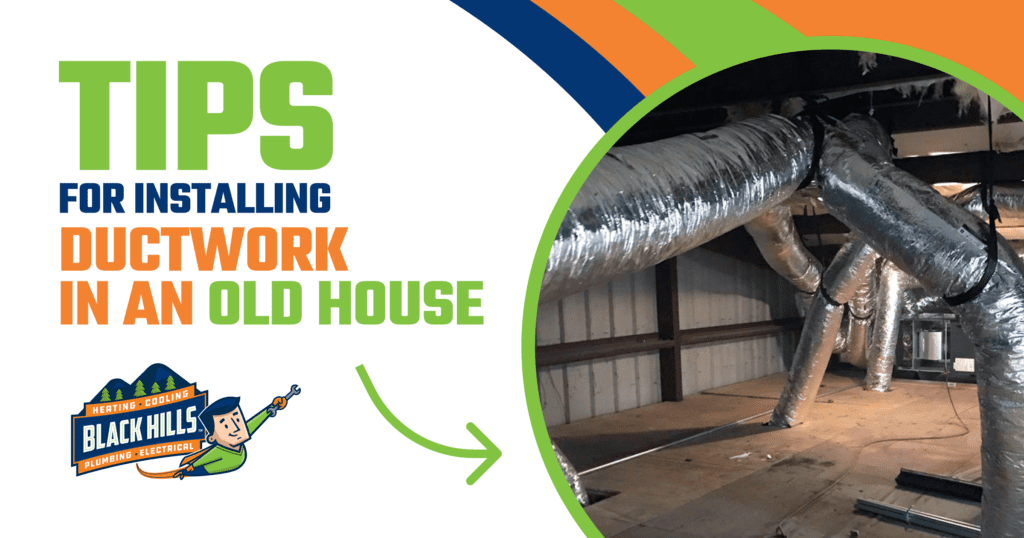Old homes can be charming but often lack the comfort and convenience of modern heating and cooling systems. Updating your HVAC unit usually requires installing bulky air ducts. While the property may not have been designed for ductwork, there are options for you to reap the benefits of a fully conditioned space.
Installing ductwork in your older home is one possibility to consider, along with alternative options that can save you stress, time, and costs.
Important Ductwork Considerations
If you’re installing a central air conditioning unit in an old house, or a heat pump system, the first thing to think about is whether you have enough power. A central AC unit often requires 20 to 50 amps. Meanwhile, a home built in the mid-20th century often only has a 60-amp service panel. Modern panels support 100- or 200 amps of power. You may need to invest in a new circuit breaker panel before you do anything else.
Other considerations when planning for new ductwork in an old home include:
- Amount of Cooling Needed: A load calculation test will determine the cooling capacity your home needs based on its size and other factors. Capacity is measured in British Thermal Units (BTUs). The AC and its ductwork must be just the right size, or the system won’t work efficiently. Your home will be less comfortable and possibly more humid.
- Seasonal Energy Efficiency Ratio (SEER): A high-SEER system is practical if your region has a long cooling season, and you use the AC often. However, gaps in baseboards, cracked moldings, and loose windows and doors can offset any cost savings due to air leakage. To get the most out of your ductwork, your home must have a well-sealed envelope.
- Type of Air Conditioner: A common variety is the rooftop split system, which features an outdoor condenser and a coil/fan system with air handlers inside. You’ll also need room for refrigerant pipes. Packaged systems combine all components in one unit. They’re less common but effective in certain situations and similar to window air conditioners. Installing multiple window ACs is one alternative to installing ductwork (we’ll detail others later).
What If My House Doesn’t Have Ductwork?
Many older homes don’t have the space required for ductwork. Breaking down plaster walls and intricate finishes may seem like the only option. But, this can be time-consuming, expensive, and requires a major cleanup after you’re done. Here are some alternative ways that HVAC contractors go about installing central air ductwork in older homes:
- Install the indoor unit in the basement or attic.
- Lower high ceilings to create space for ductwork.
- Hide ducts within boxed corners.
- Install the HVAC system under the floor along with floor vents.
- Lay ducts in the attic and connect with the registers in rooms (for single-story homes).
- Run ducts through closets between levels from the attic (for a two-story home).
Find an Alternative to Ductwork
If space is extremely limited, and you don’t want to install traditional ductwork in your older home, you can avoid the hassle altogether. Window ACs are an option, but they do have their drawbacks. There are other alternatives to installing ductwork, a few are:
1. High-Velocity Mini Ducts
A mini-duct system uses similar components and operates on a similar principle as a standard HVAC system. However, higher air speeds improve flow by creating a vacuum, which pulls more air back toward the source. The air in a room is better mixed, and the temperature throughout is more consistent. Mini-duct systems also minimize thermal loss (increasing efficiency) and remove more humidity. Nonetheless, you’ll still need to install trunk lines, flexible ducts, and other components.
2. Ductless Mini-Split Air Conditioner
You can forgo the idea of installing ductwork with a mini-split system. It uses an outdoor unit that connects to indoor air handlers that heat or cool individual rooms. In some cases, you can add up to eight indoor units. Installation is much simpler than with ducted central systems or mini ducts. You’ll only need a three-inch hole for the conduit to pass through a wall. It contains the tubing, cables, and drain line. This is a good retrofit if it’s not feasible to add new ductwork to your old home.
3. Evaporative Coolers
Evaporative coolers, also called swamp coolers, use water to cool air through the process of evaporation. However, these systems are most effective in dry climates. They do not require ductwork but need access to fresh air, so they are often installed near windows or vents. When using an evaporative cooler, windows are opened slightly to allow warm indoor air to escape as it is replaced by cooler air. Unlike central AC recirculating the same air, evaporative coolers provide a continuous stream of fresh air into the house.
Let Black Hills Help Find the Best Solution
Black Hills Home Services offers heating and cooling installation, including ductless mini-splits, throughout the Olympia area. If you have an older house, we can evaluate your options for installing new ductwork or other alternatives.
Learn more by checking out our AC and heating installation and replacement services. To schedule an appointment, book a service online or call 888-688-7358 today.

